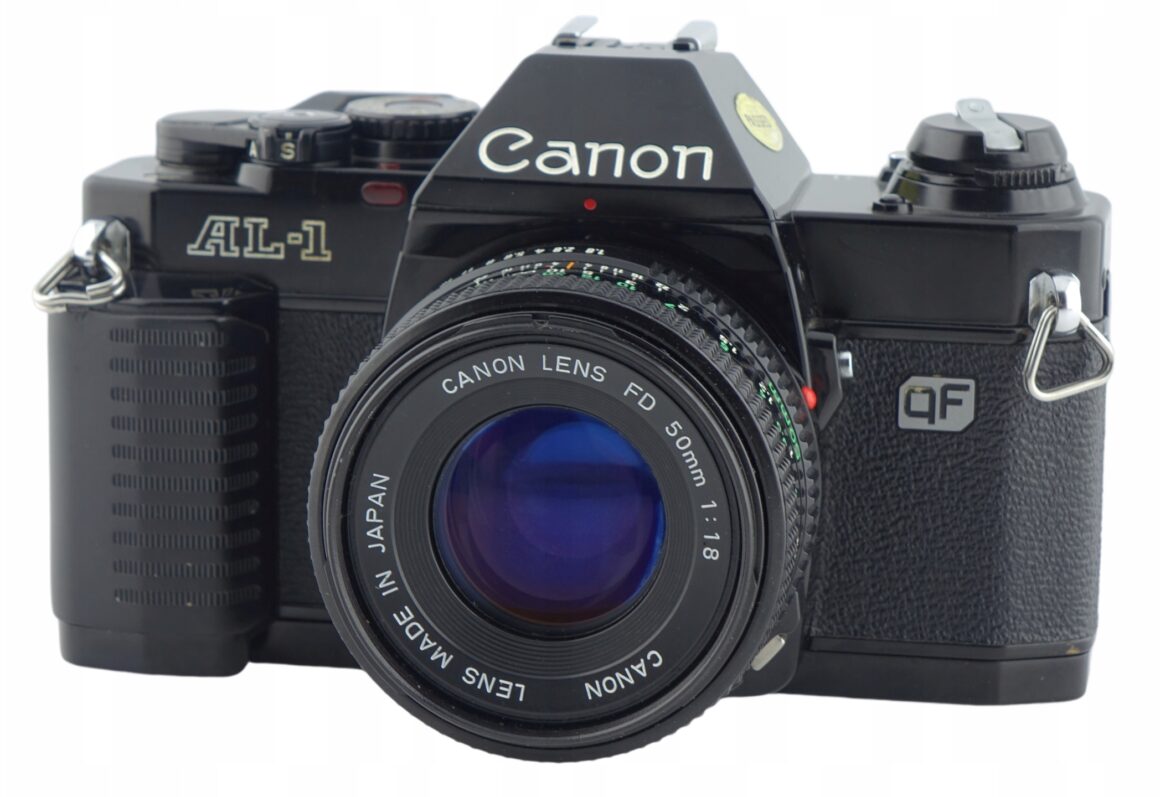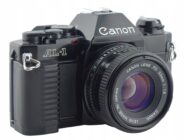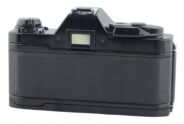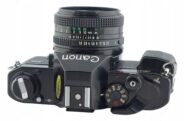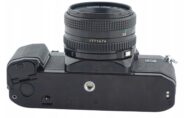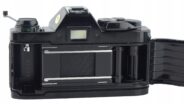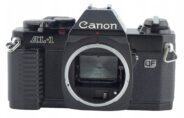Canon AL-1
35mm MF film SLR camera • Discontinued
- Announced:
- · March 1982
- Production status:
- ● Discontinued
- Country of design:
- · Japan
- System:
- · Canon FD (1971)
Specification
| Format: | |
| 35mm full frame | |
Film type: | 135 cartridge-loaded film |
| Canon FD [42mm] | |
| Shutter: | |
Type: | Focal-plane |
Model: | Electronically controlled |
Speeds: | 2 - 1/1000 + B |
| Exposure: | |
Exposure metering: | Through-the-lens (TTL), open-aperture |
Exposure modes: | Aperture-priority Auto |
| Manual | |
| Physical characteristics: | |
Weight: | 490g |
Dimensions: | 142.1x86.5x47.6mm |
Manufacturer description #1
Targeting users who had difficulty focusing through the viewfinder, the AL-1 featured an electronic focus-assist system besides aperture-priority AE.
The system searches for the peak of the subject’s image contrast obtained by three linear CCD arrays. The bottom of the viewfinder has arrows indicating the direction to turn the focusing ring to achieve focus. When focus is achieved, the in-focus mark between the two arrows lights.
The exposure is controlled by a TTL silicon photocell and aperture-priority AE with centerweighted averaging metering. All shutter speeds are electronically controlled and stepless. The camera is also compatible with all FD lenses.
Manufacturer description #2
Canon's Quick Focus System Points the Way to Sharply Focused Pictures
"All you have to do is focus and shoot", camera ads frequently proclaim. But what if your customer, due to either inexperience or eyesight problems, can't focus well? Canon, well aware of the problem, set itself the task of developing an electronic focusing system which would aid the photographer in producing sharp, blur-free pictures. The result is the OF (Ouick Focus) System.
The OF system is easy to use. Aim the camera so that the focus frame in the center of the viewfinder covers the subject. Now press the shutter button lightly. One of three indicators will light below the image. The red ► indicates that the point of focus is beyond the subject and that the lens' focusing ring should be rotated to the right, while ◄ tells you that you are focused in front of the subject. Turn the ring to the left. When the subject is in sharpest focus a green ○ lights. Press the shutter button all the way to take the picture. The system is fast and accurate and - a great advantage - functions with any FD lens. Here's how it works: Light from the lens passes through the patterned mirror to a sub-mirror behind. It then travels to a bank of 3 CCD line sensors at the bottom of the camera via a triple beam splitter. Image contrast data obtained from the sensors are computed by a microcomputer which then transmits instructions to the LED focusing indicators in the finder.
Patterned Main Mirror
The main mirror is inscribed with an intricate pattern of lines. These allow light to pass through to a sub-mirror behind and thence to the 3 CCDs for OF computation. The central area has a transparency of 45%, the mirror's reflectivity increasing progressively toward its edges. This design provides an ideal balance between the requirements of the Ouick Focus system and the light distribution of the viewfinder. The finder itself is brighter than in the case of the half-mirror system utilizing a translucent partially reflective film.
Triple Beam Splitter
Comprising four microprisms with three reflective surfaces, the triple beam splitter separates the light into three equal parts as it passes through to the CCDs below. In this way, it correctly divides all types of light, ensures uniformity of the image characteristics for all three CCD sensors and guarantees that the contrast in front and rear directions is the same when the camera is in focus and also that ghost images won't affect the performance.
Three CCD Line Sensors
The OF system utilizes three CCD (Charge Coupled Device) line sensors to detect the image. The center line sensor is positioned so that the focus of the image formed on its surface corresponds to the one that will appear on the film. The two outer line sensors mutually compare the image contrast (the focus is sharpest when the image conditions before and behind the center line sensor are the same). The center line sensor ensures that false signals won't be generated when the image is extremely out of focus. Each CCD comprises 112 cells which divide the subject into minute sections then convert them into electrical signals. The signals are serially transferred to the SFP (Sharpness Function Processor) for analog processing and from there to the CPU, which commands the OF system and activates the LED indicators in the finder. The CCDs can measure even the tiniest of subjects and have a wider dynamic range with high sensitivity and low dark current. Moreover, they are highly reliable, producing neither electrical nor mechanical noises.
Dual Exposure Modes: Aperture-priority AE + Manual Override
The AL-1 is an Aperture-priority AE SLR which also offers the option of Manual exposure control. Selecting the automatic exposure mode is a simple matter of turning the selector dial to A and choosing the desired aperture. Shutter speeds are electronically and steplessly controlled from 1/1000 sec. down to 2 full seconds. Aperture-priority AE is ideal for situations which call for a greater degree of control over depth of field. Indirect control of shutter speed is possible, too, by opening or stopping down the aperture for faster and slower speeds, respectively. Manual exposure is equally easy. The selector dial has a safety lock to guard against accidentally disengaging the A setting. To release the lock, depress the button on top and turn the dial to the desired shutter speed. Eight manual shutter speeds are available: 1/1000, 1/500, 1/250, 1/125, 1/60 ↯, 1/30, 1/15 and B. Turn the lens aperture ring to a suitable aperture. With aperture-priority AE for fast-moving scenes and manual override for situations requiring more creative attention, the AL-1 is clearly a significant step above the average "focus-and-shoot" camera. And the AL-1 owner can rest assured that the Quick Focus system will function perfectly in either mode.
Backlight Control Switch
Conveniently positioned, this switch allows you to compensate when the sun or another light source is behind the subject. Press the button while taking the picture and the shutter speed will be automatically lowered 1.5 steps.
Battery Chamber
Considering its numerous OF and exposure functions, the AL-1 consumes surprisingly little power. Power for all functions is provided by two AAA-size 1.5V batteries, sufficient for approx. 30 rolls of 36-exp. film under normal temperature conditions.
Shutter Release/Self-timer
Risk of blurred photographs is further reduced by the soft-action electromagnetic shutter release. A finger rest reduces fatigue. As with others in the A-Series, pressing the button halfway provides a meter reading and, here, OF ranging as well. Depress the button all the way to take the picture. The shutter release also incorporates a 10-sec self-timer. An LED on the front flashes to indicate its operation.
Battery Check Button
Press this button to check the condition of the batteries. The viewfinder exposure meter needle will rise above the battery check/camera shake warning index if power is sufficient. The button can also be used to cancel the self-timer.
Film Speed Dial
The AL-1 's film speed range is a wide ASA 25-1600. Press the lock release button and rotate the dial to the correct ASA setting for the film in use.
Action Grip
A new design, the grip is large and well-contoured so as to fit firmly and comfortably in your palm.
Canon's FD Lens System
The great advantage of owning a single-lens reflex camera is that its lenses are interchangeable. Canon, with its FD series, offers the AL-1 owner a choice of over 50 superlative interchangeable lenses running the entire focal length gamut from 7.5mm to 800mm. Depending on the particular purpose, there are wide-angle lenses which provide great depth of field and perspective, powerful telephotos for reaching distant subjects, handy all-purpose zoom lenses and special optics such as Macro and TS lenses for architectural and scientific applications. A common feature of them all, however, is their superb quality. Outstanding resolution and color balance, greater edge-to-edge sharpness and minimum flare and aberration are some of the many superior characteristics of Canon lenses. Moreover, their compactness and light weight make them easy to use.
Manufacturer description #3
Type: 35mm SLR (Single-lens Reflex) camera with electronically controlled AE (Automatic Exposure).
Format: 24 x 36mm.
Usable Lenses: Canon FD (for full aperture AE) and most FL (for stopped-down AE) series lenses.
Viewfinder: Fixed eye-level pentaprism.
Field of View: 92% vertical and 93% horizontal coverage of the actual picture area.
Magnification: 0.87X at infinity with a standard 50mm lens.
Viewfinder Information: Focus frame, focus indicators, shutter speed scale, meter needle, red over and underexposure warning indices and battery check/camera shake warning index.
AE Mechanism: Aperture priority AE control.
Shutter: Cloth, focal plane shutter. Electronically controlled.
Shutter Button: Electromagnetic, two-step button. Pressing it halfway activates the meter and the Quick-focus system; pressing it all the way sets shutter in operation. With lock and cable release socket.
Shutter Speed: Automatically controlled, steplessly, from 2 sec. to 1/1000 sec. Manual settings for 1/1000, 1/500, 1/250, 1/125, 1/60 ↯, 1/30, 1/15 sec. and B.
Meter Coupling Range: EV1 (1 sec. at f/1.4) to EV18 (1/500 sec. at f/22) with ASA 100 film and the FD 50mm f/1.4 lens.
Metering Range: EV3.5-EV18
Film Speed Scale: ASA25 - 1600
Backlight Control Switch: Shutter speed is automatically reduced 1-1/2 steps to increase exposure by pressing back-light control switch.
Flash Synchronization: At 1/60 sec. Set by switching selector dial to 60 for flashes other than a Canon Speedlite Direct contact at accessory shoe.
Mirror: Large instant-return type with shock-absorbing mechanism and Computer aided pattern.
Self-timer: Electronically controlled. Ten-second time lag activated by pressing shutter button. Red LED blinks to indicate operation; flashing frequency increases two sec. before shutter release.
Automatic Flash Control: With Canon speedlite 011A, 133A, 155A, 166A, 177A, 188A, 199A, 533G or 577G. With selector dial at "A," shutter speed set to 1/60 sec. automatically. Aperture set manually on aperture ring to same aperture set on flash.
Light Metering System: Through-the-lens (TTL), Center-weighted average by silicon photocell (SPC).
Camera Back: Fixed. Opened by pulling up rewind knob.
Film Loading: Via multi-slot take-up spool.
Film Advance Lever: Single-stroke 120° throw with 30° stand-off. Winding with several short strokes possible. Automatic winding possible with optional Power Winder A.
Frame Counter: Additive type. Automatically resets to "S" upon opening back cover.
Film Rewind: By pressing rewind button and cranking rewind knob.
Focus Signal: 3 ways with LED (Light Emitting Diode)
Power Source: Two 1.5V alkaline manganese (Size AAA, LR03) batteries
